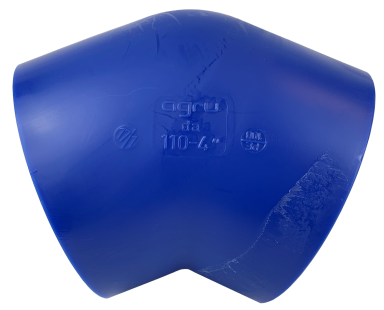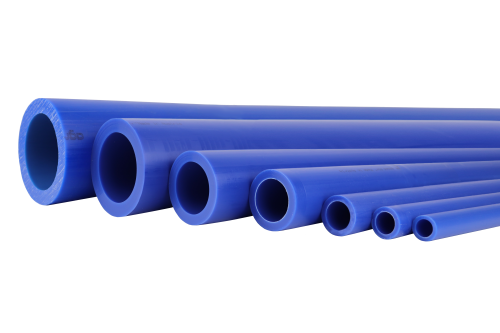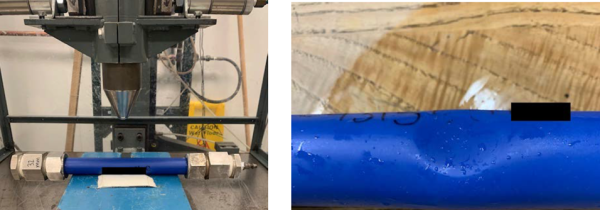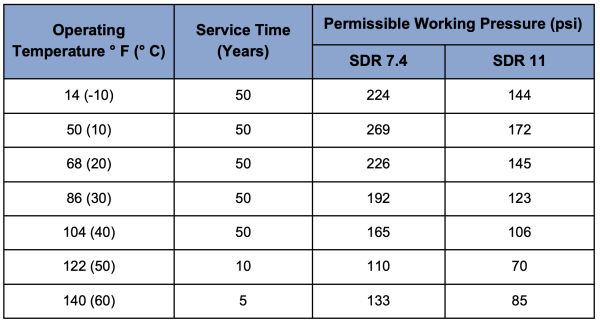Compressed air is used in nearly every industrial facility: pulp and paper, power, industrial manufacturing, metal processing, medical, pharmaceutical, aerospace and railroads. It can operate instrumentation, cool hot devices and handheld tools, float material from one place to another and much more. With such a large volume of air pushed around a facility, how do you specify the proper piping material? Although compressed air piping systems exist in a variety of materials, such as stainless steel and aluminum, this article will discuss thermoplastic piping systems.
Compressed Air Piping Regulations
Compressed air piping systems contain high amounts of stored energy, which can be dangerous if released suddenly. Most plastic pipe systems are not suited for this application. The Occupational Safety and Health Administration (OSHA) has issued rulings regarding the use of thermoplastic piping materials for these applications. According to OSHA’s regulations, if thermoplastic piping materials are used for compressed air or gas applications, “the pipes must either be constructed of or be encased in shatter resistant materials” (OSHA Standard Interpretation, February 29, 1991).
High-density polyethylene piping system, or PE100, has passed California’s Division of Occupational Safety and Health (CAL/OSHA)’s test requirements for use as compressed air piping. Certain thermoplastic piping manufacturers have designed a marking on PE100 piping, intended for compressed air, and the joining methods of PE100 meet the requirements of California Unified Pressure Vessel Safety Order 462 (m) (3). The blue color of PE100 piping is the ANSI/OSHA schematic hue for compressed air pipelines. PE100 also meets the following: ASTM D1599 Quick Burst Pressure Test and ASTM D1598 1,000 Hour Pressure Test. Based on these requirements, other material, such as polyvinyl chloride (PVC) or polypropylene (PP), do not meet these requirements as they tend to fragment at overpressure failure and fail the impact test set by CAL/OSHA.


Asahi/America’s Air-Pro® compressed air piping system is engineered and manufactured by AGRU Kunststofftechnik GmbH. Air-Pro® socket fusion fittings 1/2 to 4-inch are molded with the manufacturer’s name (AGRU), the size in millimeters and the inch equivalent. Quadrant hash marks are molded on the fittings to assist the pipe fitter. Each is stamped with its date of manufacture (year, lot run) and material.
Thermoplastic Piping Material
How does PE100 meet these pressure requirements? By using a specifically formulated polyethylene material compound with antioxidants for compressed air service that is manufactured and tested to all applicable International Organization Standardization (ISO) standards. Polyethylene (PE) pipe and PE100 resin meet ISO 15494 supplement B (Minimum Required Strength of MRS 10), ASTM D3350 minimum cell class PE445476E for 1/2 to 4-inch blue and cell class PE445476C for 6 to 12-inch black color. The testing certification for pipe and fittings are per EN 10204 standard per ISO test specifications. It also maintains a Hazen-Williams (HZ) number of 150. Thus, giving PE100 a superior advantage over other forms of compressed air piping. Using butt fusion, socket fusion or electrofusion welding techniques helps reduce any potential leak areas that a flange or threaded connection system can have during operation.
A13.1 establishes a common system to assist in identification of fluids conveyed in piping and their characteristics. The standard describes requirements for the identification of above ground piping used in industrial, commercial, transmission, distribution and institutional installations, and in buildings used for public assembly. It does not apply to electrical conduits. From the American Society of Mechanical Engineers (ASME) A13.1 Scheme for the Identification of Piping Systems.
Resistance to Compressor Lubricants
Air compressor manufacturers recommend a wide variety of lubricants for proper operation of their equipment. Some compressors are designed to be oil-free, while others require either a synthetic or mineral-based lubricant. There is always a chance lubricant present in trace amounts may be entrained in compressed air and transferred to the air piping system. PE100 material is formulated to be resistant to compressed air with trace amounts of compressor lubricants including mineral oils, synthetic blends, polyalphaolefin (POA), polyol-ester (POE) and diesters.
This allows thermoplastic piping material, like PE100, to have limited buildup of lubricants on the pipe wall and assists in keeping the compressed air line at its designed pressure and volumetric design.

Polyethylene (PE100) remaining intact under pressure test. At over 800 psi (55 bar), PE100 would simply open an orifice keeping the pipe material intact. No hazardous projectiles would come off the piping.

Polypropylene (PP-RCT) shattering under pressure test.
Resistance to Water Vapor and Corrosive Environments
What other factors determine the choice of a compressed air system? Water vapor is often present in compressed air systems and is a constant battle for compressed air operators. The presence of moisture can and does act as a corrosive element to metal piping causing rust or metal fatigue over time. It also lowers the efficiency and cleanliness of the system as a result of moisture in the service line. This can cause particles to dislodge and travel into the process where air is used and can have a disruptive effect on instrumentation, actuation and other applications for compressed air. For most manufacturing processes, this is unacceptable because it impacts the quality of the products and increases quality control rejection rates. PE100 is inherently immune to issues related to moisture because it does not rust, scale, pit or corrode.
Issues like these are also present in outside environments. Chemical atmospheres, salt water presence and ultraviolet sunlight (UV) that are often present in steel mills, pulp and paper facilities and chemical processing facilities, can have a detrimental effect on other forms of compressed air piping. PE100 is an ideal solution in these environments as it is rather impervious to chemical attack and salt water rust, and is UV resistant, which allows for a complete compressed air system in most environments.
Additionally, PE100 is ideal in vacuum service applications. Theoretical full internal vacuum at sea level is 29.92 Hg or -14.7 psi (-1 bar). In general, PE100’s external or negative pressure rating is much higher than theoretical full vacuum. This is important because there are other variables besides internal vacuum that could contribute to negative pressure on the hoop stress of pipes. As with all unreinforced thermoplastic pipe systems, both positive and negative pressure ratings decrease as temperatures rise. When designing a vacuum or a positive pressure compressed air system with the highest possible temperature the pipes will be exposed to, the desired useful service life should be considered.
Life Expectancy
Here are two typical applications of compressed air piping system applications:
Example 1:
P1: 120 psi (8 bar)
T1 max: 104°F (40°C)
Line Size: Varies
Flow Rate Q: Varies
SG: Compressed Air
This above example gives you an expected life span of 50 years in an SDR 7.4 system.
Example 2:
P1: 100 psi (7 bar)
T1: 86°F (30°C)
Line Size: Varies
Flow Rate Q: Varies
SG: Compressed Air
This above example will give you an estimated life span of 50 years in SDR 7.4 or SDR 11 pipe applications.

Based on long-term tests of aging stability in temperature-controlled, oxygenated fresh water and creep rupture testing of the material as per DIN 8075, it is possible to calculate the service life of the Air-Pro® piping system at permissible working pressures and various temperatures. Note, temperatures below 50°F (10°C) and above 68°F (20°C) decrease pressure rating.
Each of these examples are common in pulp and paper, chemical plant, bio-pharmaceutical, steel mills and other industrial facilities.
Conclusion
In order to select the proper material for your compressed air lines, the following information is required:
1) Total required flow for system – cubic feet per minute (cfm)
2) Operating supply pressures at points-of-use
3) Length of pipe runs
4) Number and types of fittings
5) Number and type of valves
6) Future expansion
7) Service conditions pressure/temperature
8) The system’s location for outside environmental concerns
9) Above ground, below ground (buried) exposure to UV
10) Lubricants
These 10 specifications will assist the user in determining the proper selection of material for the compressed air piping system. The final determination is to ask the manufacturer for an estimated life expectancy letter. This will be based on the pressure/temperature of the system and can give you the knowledge that your compressed air piping system will last a certain number of years.
Once all of these factors have been considered, the system can be installed in an economically impactful investment for a facility.

This cfm chart can be used for quick reference to determine the proper size of Air-Pro® pipe for given applications. Note, calculations are based on a 1.5% pressure drop for 100 feet of Air-Pro® pipe. For more information, see Asahi/America’s Air-Pro® product guide and installation manual.
About the Author
Mark Gore has been with Asahi/America for 18 years as a District Sales Manager and transitioned to a Business Development Manager in 2022 for Asahi/America’s marine, metal finishing, oil and gas, power and pulp and paper market verticals. His projects and tasks include life cycles – material selection, design, cost and start up, as well as equipment selection and training with architecture and engineering end users and contractors.
About Asahi/America
Asahi/America, Inc. is a diversified ISO 9001:2015 certified manufacturer and leading supplier of corrosion resistant thermoplastic valves and piping systems for over 40 years. For more information, visit https://www.asahi-america.com.
To read more Compressed Air Piping System articles, visit https://www.airbestpractices.com/system-assessments/piping-storage.
Visit our Webinar Archives to listen to expert presentations on Compressed Air Piping Systems at https://www.airbestpractices.com/webinars.




